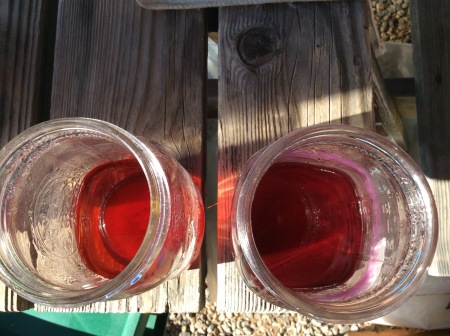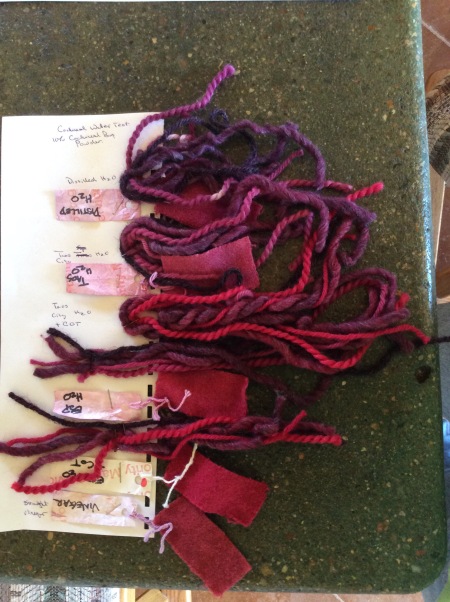Another dyer and I got together for a day of dye experiments with cochineal. We had several questions to which we wanted answers. The first one and the one which we never resolved was an issue with cochineal washing out of silk scarves. She used a recipe published in Liles book which uses tin and oxalic acid with cochineal. We tried washing the dyed scarf in orvis paste and hot water. The dye washed out. We soaked another dyed scarf in vinegar and the dye washed out in hot water. My conclusion is that the hot water is breaking the relatively weak bond between the tin, oxalic acid, cochineal, and silk. We also tried dyeing silks scarves with the one pot recipe from Garcia. That also washed out. Subsequently, I consulted with some other natural dyers and it was explained to me that Garcia’s recipe is more along the lines of an acid dye than a traditional mordant dye so that is why it is washing out. I assume the tin/oxalic acid is similar. It was suggested that traditional mordant alum based mordant method would work better. (As an aside, I looked for the recommended % of alum on silk and it ranges from 5 – 100. Most of the dye books say mordant like other protein fibers. I haven’t been able to find any studies that compare % of alum on silk.) Second question: cochineal is very sensitive to water and ph. It is often recommended that you use distilled water. Garcia suggests adding cream of tartar to tap water when dyeing with cochineal as the cream of tartar acts as a buffer to what is in the water. We ran an experiment using different water sources and distilled water with and without cream of tartar. Below is a picture of the sample cards and a picture of one of the sets of jars with and without cream of tartar. The interesting observation is that all of jars without cream of tartar had the same amount of particulates in the bottom of the jar. The jars with cream of tartar didn’t have anything in the bottom of the jar. My conclusion is that cream of tartar does act as a buffer and it is not worth using distilled water unless you have water that will not work with cochineal. The three instances that I know of where cochineal would not dye with local water was water that was runoff from a mining area. water with iron, and water in which there was sulfur. The yarn samples are premordanted with 25% alum. There are some white, grey, brown, and black wools in the samples. The wool cloth sample is unmordanted. 
 Finally, I wanted to see the results of two other mordants with cochineal; symplocos (premordanted 50% WOF) and titanium (5% WOF) Below are those results on silk and wool.
Finally, I wanted to see the results of two other mordants with cochineal; symplocos (premordanted 50% WOF) and titanium (5% WOF) Below are those results on silk and wool. 
Tags: Natural Dyes
Leave a comment